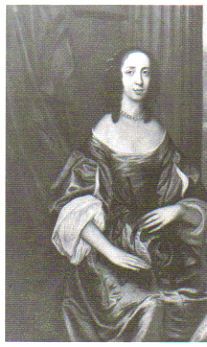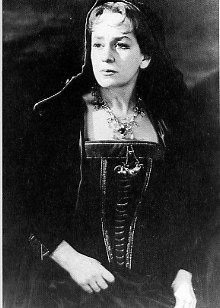Ellen and Jim Have a Blog, Too
We are two part-time academics. Ellen teaches in the English department and Jim in the IT program at George Mason University.


Women's Memoirs and Self-Presentation through Things · 4 April 06
Dear Marianne,
I had been self-consciously uncomfortable about how Edward and I had arrived Wednesday so as not to miss any sessions. The first occurred Thursday at 8:30 am. How wrong I was there: by chance that session was the best I attended.
It was called "Women’s Autobiography in the Long Eighteenth Century," and the range allowed for three papers, one on Lucy Hutchinson, one on women’s scandalous memoirs in the middle of the 18th century, and one on Mary Wells, an actress I’d never heard of before.
The first paper on Lucy Hutchinson was informative. I learned Hutchinson was a continually writing woman: she left not only the full remarkably politically perceptive biography of her husband, and her short candid autobiography of herself; she also left long and many poems, translations, and treatises. Who knew?
She wrote poetry all her life, and, as a sort of counterweight to her continual protestations of religious faith, translated Lucretius. She wrote elegies which reveal her view of her husband, poems on the principles of religion, autobiographical verse telling about her parents and herself and her relatoinships with her children. There is a notebook which is itself the basis of her biography. All shows how learned she was: how much she read.
Most striking is the view Lucy offers of her mother. There’s a full portrait of the mother before she was married, and how she married a man much older than herself [very common in the early modern through 17th century eras]. Lucy tells of how troubled she felt over her mother’s open preference for a younger sister who was not "bookish." Virginia Wooolf’s description of her desperate ways of finding time and space to write resemble Lucy Hutchinson’s.
The speaker argued that Hutchinson’s whole corpus is in effect a long autobiography—rather like Boswell’s Johnson is an interlude in Boswell’s autobiography. Lucy Hutchinson was creating herself through this delineation, discovering who she was.
Lucy Hutchinson (1620-?76)
The second paper was useful. The speaker suggested that if you read through the scandalous memoirs of the 18th century, you discover a number of repeating patterns and characteristics. She labelled the memoirs as a group female appeals, and described these features. I am not beginning to doing justice to this one by this summary; I include only a synopsis of some of what was said:
They are first-person narratives about a woman whose actions or thoughts in life have led to loss, displacement, and distress for her. They are written by herself and self-published. The losses include chastity, status, financial loss, having to go to court and endure legal battles, loss of home, children, liberty, security, place, country. Unable to obtain redress, she is forced to write. The memoir is a public appeal for financial assistance and justification of the self. She needs help against her enemies.
The process of appeal becomes part of the story. The writer usually says she has had much trouble publishing it.
The book is a vindication of her character. She refutes specific scandal and libels, and challenges the maxim that loss of chastity means the woman has become worthless. She usually says that circumstances led to her doing what she had to do.
The book functions as a prosecutor. She reveals the systems which oppress her. She must expose some of the characteristics of the system to censure it. She often reveals the cruelty and harshness of other women to her.
The books function socially to render laws and circumstances concrete. They show how these work out in reality and particulars. They are memoirs; they appeal to the reader for a solution; she situates herself in society. They are presented as truth.
An introductory section tells us why the author publishes the memoir. [I note this was cut off of Anne Murray, Lady Halkett’s memoir, and later editors often substitute their own quite different introduction. I discovered in the session that the consensus for referring to Anne Murray, Lady Halkett is Halkett even though the source of her importance and activities came from her having been a Murray, daughter to the man who was tutor to Charles I and woman who was governess to Charles I’s daughter.]
They have typical phases which include failure, fall, a life crisis. The pattern resembles that of a novel. [I remarked later that real lives include much improbability so paradoxically a more literally truthful memoir might seem improbable, and would have to depend on the attitude towards the woman in the reader to begin with for what effect it might have.]
They will include letters, poems, brief biographies and other documents. These provide evidence. Unhappily some modern editions omit these sections. [This reminded me of how much poorer the Broadview edition of Oliphant’s memoirs is because it omits the second half of the book that Oliphant’s niece created: one filled with fascinating intelligent and sometimes passionate letters, apparently on business, between her and her publishers and occasionally friends.]
They are written in an informal disgressive style. This makes them seem more authentic. This is sometimes praised by reviewers. [I remembered how Hester Thrale was excoriated and mocked for her ungrammatical and prosaic style.] The style provides a sense of intimacy.
The third paper was on Mary Wells’s autobiography. I had never heard of Wells and the point of view on the autobiography was perceptive about the relationship between what she wrote and how it ironically affected Wells’s strained life.
Wells lived from 1762-1829. She is often set apart from other actresses because she was put in an asylum as mad. The argument was that Wells’s book functions as an epitome of modern celebrity culture. In modern books the stories and identities project cultural fantasies and anxieties of the readership. Here we have a woman attempting to vindicate her character.
Mary Well presented herself as mad and gives sad evidence of herself as an outcast. What on stage was seen as comedy, in life was seen as infamous, outrageous, and led to her being put away.
At the center is a woman who is apparently not controlling herself.
Sarah Siddons wrote that either she was mad or affects to be so, and apparently thought it was the latter.
Among the most famous incidents: in 1789 Wells hired a yacht she called the Cleopatra and followed George III rather like Cleopatra followed Anthony (or dressed up in front of Caesar).
The questions about this book include: was she enacting madness in order to avoid arrest for debts? She presents herself as a victim (of men’s adultery). On the stage she played the character of Sophia Strangeways in a play by Reynolds, and the play seems to replicate aspects of Wells’s character and life. The theatrical anecdotes include her as an idealized mother framed unconventionally: for example, she uses her daughter to help her escape something.
Her narrative failed to rescue her reputation, and she died penniless and alone: her children had been taken from her. What this narrative shows is a woman acting out (as young women do today). She was later when mentioned contrasted with docile heroines.
The second session of the first (Thursday) morning I went to, "Constructing Space and Identity in the Eighteenth Century Interior" had the worst paper I heard. A woman wrote a long-winded jargon-ridden paper to prove what everyone already knows: that the people and characters of the 18th century built their identities (as we do today) through what they bought, wore, and where they lived, their furnishings. Alas, that was the one Edward came to with me, and he left immediately afterward. (He spent a lot of time with his laptop on his lap in the large central hallway in a chair he discovered had was in a tiny area with serendipitous connectivity to the Internet.)
The session also included a paper where the speaker argued that courtesans projected a series of cultural types they wanted to be identified with through the furnishings of their apartments.
In truth 18th century courtesans all lived contingent and financially precarious lives. They lived on their salaries from day to day and often died in poverty and illness. The projected image was one of luxury, eroticism, and splendor and success. [This resembles the reality of actresses lives and its contrast to how they were and are still presented in media.]
So the courtesan placed herself in a spectacle she built up as a backdrop to herself. She played the parts of a woman of luxury, an intellectual woman, a heteira, a woman of sensibility. [She also when attached to a wealthy powerful man might play the part of patroness.] Pompadour would be an epitome.
The objects most often presented in public include carriages, collectors’ items (porcelain, bronze, paintings, books). They would have music and musical instruments. Collections of shells and specimens (birds in wax). The real fragility of their status can be seen in how often their stuff ended up on the auction block. Today this stuff is what fills museums.
They would somehow project themselves as generosity itself. The sensitive prostitute with the heart of gold.
At the end of this talk, the speaker quoted some upper class male’s joke when he visited one of these houses or a garden, "who needs the woman when you can have the furniture." [An odd quip: was he thinking of going to the coming auction?]
The last talk of this session was one where the speaker attempted to make the audience aware of how different the original interior of a place must be different from its recreation in modern museums, and also how at the time it was itself a self-consciously historical recreation. This was one of those which was so full of jargon I didn’t get much of specifics except that it was stressed that the earlier recreations and rooms and houses were presented as increasing the status of the person or family, but not as part of a world of commerce as it would be today.
In the first early morning session I was very excited to hear about Lucy Hutchinson since I am now so engaged with reading texts by and about and hope to produce an etext edition of 17th century literary English women. The perceptive and helpful description of later 18th century scandalous memoirs fits much of what I find in Anne [Murray, Lady] Halkett’s memoir. Someone in the session suggested Halkett was influenced by the memoirs of Marie and Henrietta Mancini. The last paper fit much that I learned so interesting about actress when I did my paper for an Eastern Region meeting 2 years ago: I hate such parts as wee have plaid today. It was then I learned that a number of the 18th century actresses left autobiographies or had lives written about them shortly after they died. I also read a wonderful book which includes 18th, 19th century and more recent English actresses which I recommend to you: Sandra Richards, The Rise of the English Actress (New York: St Martin’s Press, 1993).
Peggy Ashcroft (1907-91) as The Duchess of Malfi in Webster’s play (ca. 1940).
More tomorrow,
Elinor
--
Posted by: Ellen
* * *
Comment
- Dear Elinor,
Just wanted to tell you how much pleasure reading this (and your earlier paper) this morning gave me. I’d like to clothe the thought in a few more words, but those I want are escaping me.
I’m delighted the trip went well!
Miriam
— Julie V. Apr 5, 1:06pm #
commenting closed for this article


